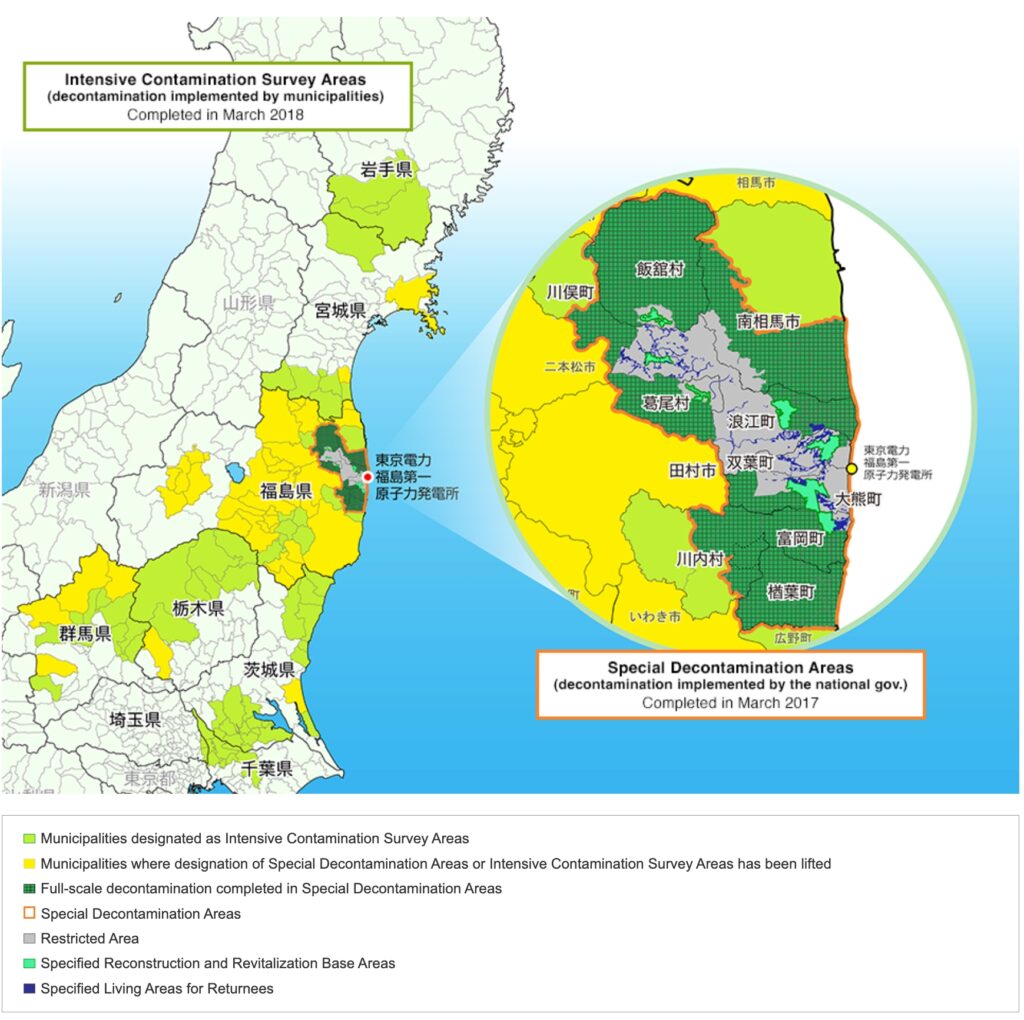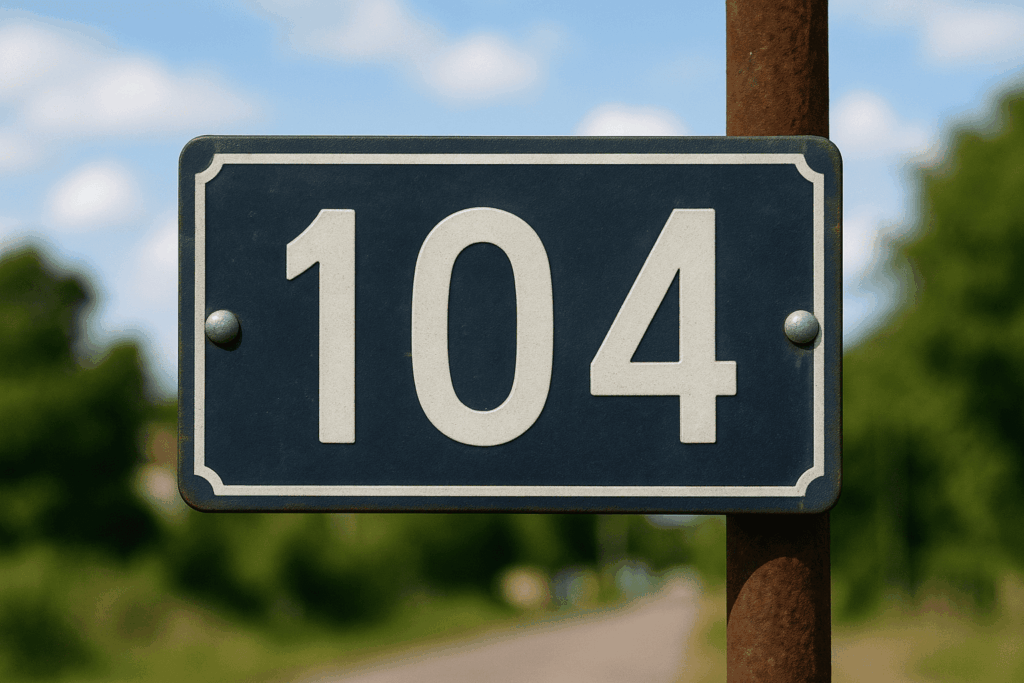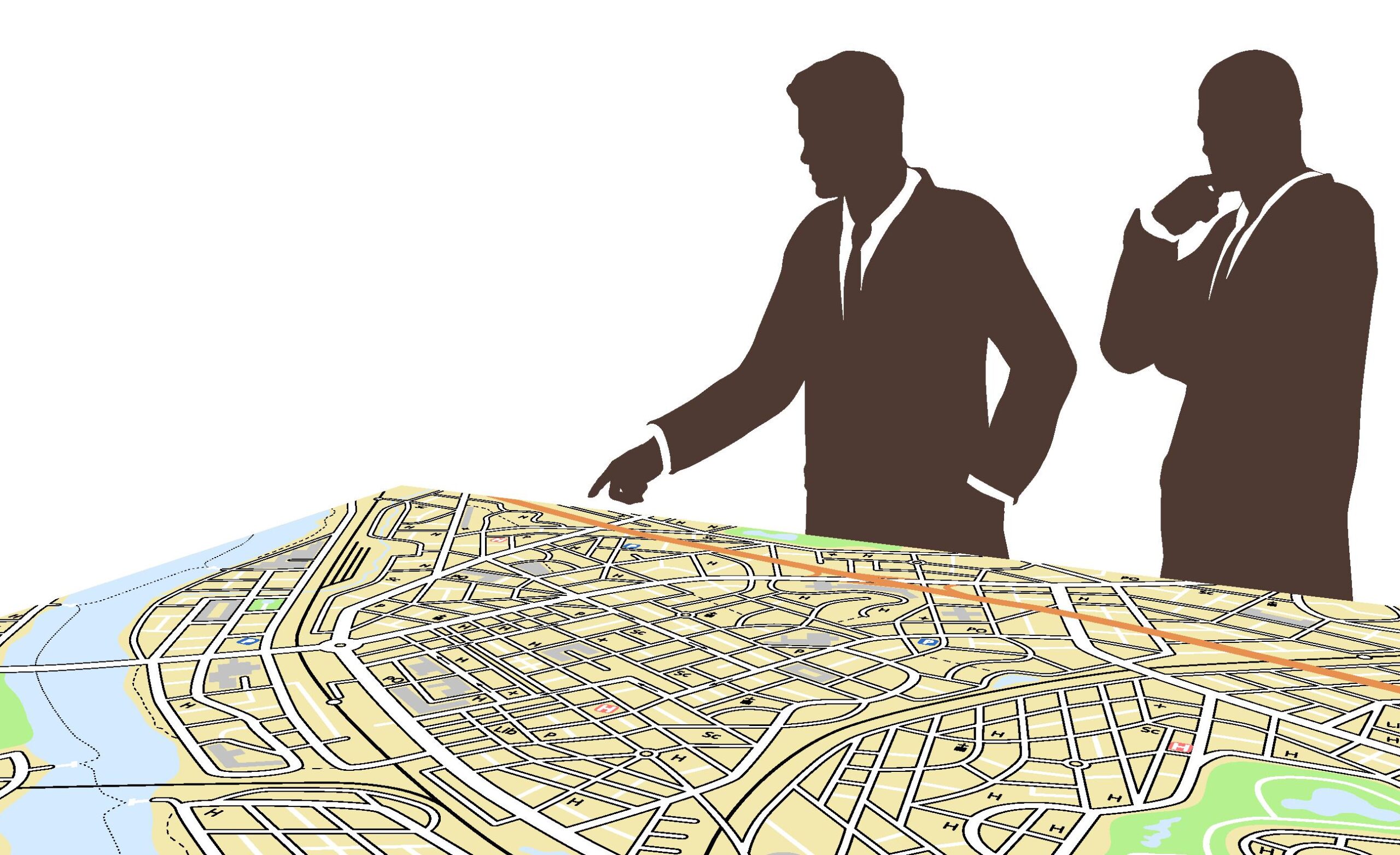Hello, everyone. My name is Daichi, an expert providing the information on the radiation issues in an easy-to-understand manner.
Have you ever heard the names of ‘Special Decontamination Areas’ and ‘Intensive Contamination Survey Areas’?
The areas where decontamination activities have been conducted, can be roughly divided into these areas, and for example, with different implementing bodies.
Today I would like to respond to the following questions:
– What are the ‘Special Decontamination Areas’ and the ‘Intensive Contamination Survey Areas’?
– Who had implemented the decontamination activities, and what is the role sharing for it?
In the following part of this article, abbreviations of the areas are as follows:
SDA: Special Decontamination Areas
ICSA: Intensive Contamination Survey Areas
RA: Restricted Areas
SRRBA: Specified Reconstruction and Revitalization Base Areas
SLAR: Specified Living Areas for Returnees
FDNPS: Fukushima Daiichi Nuclear Power Station
TEPCO: Tokyo Electric Power Company
ISF: Interim Storage Facility
Table of contents of this article
- The Special Decontamination Areas and the Intensive Contamination Survey Areas
- Basic concept for implementer of decontamination activities
- The Special Decontamination Areas
- The Intensive Contamination Survey Areas
- Future direction of both areas
- Summary
I have been involved with the radiation-relevant issues, like the policy on the decontamination activities and the management of the Interim Storage Facility, after the accident of the Fukushima Daiichi Nuclear Power Plant in 2011.
I received a doctorate in the field of radiation, while working in Fukushima.
The Special Decontamination Areas and the Intensive Contamination Survey Areas

(Reference) Ministry of the Environment, Japan (Access on 1 October, 2025)
First of all, let us begin with confirmation of geographical location of the two areas.
In the above map, the SDA are the areas bounded by an orange line.
All of the gray areas (RA) are included in the SDA, and the light blue areas (SRRBA) and the dark blue areas (SLAR), which are within the RA, are also of course within the SDA.
It is found out that they are located with in Fukushima Prefecture and in the vicinity of the FDNPS.
On the other hand, the ICSA are the areas other than the SDA and with yellow-green or yellow color.
You can find out that it spreads in Iwate and Miyagi Prefectures in the northern part of Japan, part of the areas in Fukushima Prefecture other than the SDA, as well as Tochigi, Gumma, Ibaraki, Chiba and Saitama Prefectures.
Yellow-green areas indicate the areas, which are still designated as the ICSA, and yellow areas indicate the areas, whose designation was already lifted, although they were once designated as the ICSA.
Basic concept for implementer of decontamination activities

Then what is the basic concept to categorize the SDA and the ICSA?
First, please bear in your mind that the areas of the SDA was almost consistent with the evacuation areas, when they were first set out (the former Restricted Areas and the Deliberate Evacuation Areas) (only the part of the Naraha Town was designated as the SDA, although it was not the evacuation areas).
Please visit this article for the detail of the evacuation areas.
In these areas not only the residents but also the administrative authorities were forced to evacuated, due to the accident of the FDNPS.
Therefore, it was hardly possible for the municipalities in the SDA to be in charge of the decontamination activities.
In addition, taking account of social responsibility of the national government, which had promoted nuclear power, the decontamination activities in the SDA have been implemented under the responsibility of the national government (especially the Ministry of the Environment).
On the other hand, in the ICSA, each municipality has been mainly responsible for the decontamination activities, which are well familiar with local circumstances, with financial and technical supports of the national government.
By the way, the Tokyo Electric Power Company, the operator of the FDNPS, had not become a main implementer of the decontamination activities.
Part of reasons for this seemed to be that the TEPCO needed to throw human resources for decommissioning of the FDNPS, and that radioactive materials spread into a wide range of areas, from the Tohoku to the Kanto Areas, that made it difficult for a company to address all the decontamination activities.
Regarding this issue, there was a lot of discussion about the role sharing, but I would like to touch upon this role sharing, if I have an opportunity.
In the following parts more detail information about each area is covered.
The Special Decontamination Areas

As aforementioned, the SDA are located in the vicinity of the FDNPS, and 11 municipalities (i.e. Okuma Town, Futaba Town, Namie Town, Tomioka Town, Naraha Town, Kawauchi Village, Tamura City, Minamisoma City, Iitate Village and Kawamata Town) had been designated as the SDA for a long time.
Among them, the designation of the SDA of Tamura City was lifted in March 2022, together with the lift of designation of the ICSA of the same city.
Therefore, the number of the municipalities in the SDA is 10, as of September 2025.
In the municipalities in the SDA, the necessary decontamination activities as well as the management of waste arising from the activities, have been implemented by the national government (mainly by the Ministry of the Environment), even after the lift of evacuation orders.
Please visit this article for the detail of decontamination procedures.
Full-scale decontamination activities were completed by the end of March 2017, other than the RA, and currently necessary monitoring and follow-up decontamination activities have been carried out.
In addition, simultaneously, in the RA, the SRRBA were constructed, and all evacuation orders of the SRRBA had been lifted by November 2023.
Please visit this article for the details of the SRRBA.
Afterward, the constrcution of the SLAR started in December 2023, in the RA but outside the SRRBA, to enable people to return and to rebuild of people’s life by lifting the evacuation orders.
For the details, please visit this article, incluiding the future issues in the RA.
The Intensive Contamination Survey Areas

The ICSA is located in the distance from the FDNPS compared with the SDA, and it spreads from Iwate Prefecture in the Tohoku Area, to Saitama and Chiba Prefecture in the Kanto Area.
Basically each municipality is designated as the ICSA for its whole municipality, but regarding Tamura City, Kawamata Town, Kawauchi Village and Minamisoma City, they all consist of both the SDA and the ICSA (Designation of Tamura City was lifted in March 2022).
Based on the Act on Special Measures Concerning the Handling of Environment Pollution by Radioactive Materials Discharged by the NPS Accident Associated with the Tohoku District – Off the Pacific Ocean Earthquake That Occurred on March 11, 2011 (herein after referred to as ‘the Act on Special Measures‘(in Japanese)), the ICSA is subject to be designated for the areas with more than 0.23 μSv/h of air dose rate, where further intensive survey is necessary, also taking account of opinions of relevant municipalities and prefectural governments.
The number: 0.23μSv/h will be elaborated in another article.
Full-scale decontamination activities in the ICSA had been completed by the end of March 2018, and currently necessary monitoring and follow-up decontamination activities are being carried out, as done in the SDA.
By the way, the number of the municipalities designated as the ICSA was 102, when the Act on Special Measures was completely taken into effect on January 1, 2012, which authorizes the SDA and the ICSA, and after that increased up to 104 at maximum, by adding Yanaizu Town in Fukushima Prefecture and Watari Town in Miyagi Prefecture in February 2012.
However, in the wake of decrease of air dose rate over time, and the progress of decontamination activities, the designations as the ICSA have been gradually lifted, and the number of the municipalities has decreased to 64, as of the end of September 2025 (Ref: Decontamination Information Site (Ministry of the Environment, Japan)) (in Japanese).
For the detailed, please visit the following tables.
| Prefecture | The number of municipalities | Municipalities designated as the ICSA (as of 29 March 2024) |
|---|---|---|
| Iwate | 3 | Ichinoseki City, Oshu City, Hiraizumi City |
| Miyagi | 7 | Shiroishi City, Kakuda City, Kurihara City, Shichikashuku Town, Ogawara Town, Marumori Town, Yamamoto Town |
| Fukushima | 9 | Minamisoma City, Kawamata Town, Ishikawa Town, Tamakawa Village, Hirata Village, Asakawa Town, Furudono Town, Hirono Town, Kawauchi Village |
| Ibaraki | 19 | Hitachi City, Tsuchiura City, Ryugasaki City, Joso City, Hitachiota City, Takahagi City, Kitaibaraki City, Toride City, Ushiku City, Tsukuba City, Hitachinaka City, Kashima City, Moriya City, Inashiki City, Tsukubamirai City, Tokai Village, Miho Village, Ami Town, Tone City |
| Tochigi | 7 | Kanuma City, Nikko City, Ohtawara City, Yaita City, Nasushiobara City, Shioya Town, Nasu Town |
| Gunma | 8 | Kiryu City, Numata City, Shibukawa City, Midori City, Shimonita Town, Takayama Village, Higashiagatsuma Town, Kawaba Village |
| Saitama | 2 | Misato City, Yoshikawa City |
| Chiba | 9 | Matsudo City, Noda City, Sakura City, Kashiwa City, Nagareyama City, Abiko City, Kamagaya City, Inzai City, Shiroi City |
| Total | 64 |
| Date | Municipality(ies) where designation(s) as ICSA was(were) lifted | The number of municipalities |
|---|---|---|
| 27 December 2012 | - Showa Village (Fukushima) - Katashina Village (Gunma) - Minakami Town (Gunma) | 101 |
| 25 June 2013 | - Ishinomaki City (Miyagi) | 100 |
| 17 November 2014 | - Mishima Town (Fukushima) | 99 |
| 14 March 2016 | - Hokota City (Ibaraki) | 98 |
| 31 March 2016 | - Sano City (Tochigi) | 97 |
| 8 September 2016 | - Yamatsuri Town (Fukushima) | 96 |
| 29 November 2016 | - Hanawa Town (Fukushima) -Yanaizu Town (Fukushima) | 94 |
| 22 March 2017 | - Annaka City (Gunma) - Nakanojo Town (Gunma) | 92 |
| 25 March 2019 | - Aizubange Town (Fukushima) - Yugawa Village (Fukushima) - Aizumisato Town (Fukushima) | 89 |
| 16 March 2020 | - Samegawa Village (Fukushima) | 88 |
| 22 March 2021 | - Watari Town (Miyagi) | 87 |
| 27 December 2021 | - Otama Village (Fukushima) | 86 |
| 31 March 2022 | - Tamura City (Fukushima) - Motomiya City (Fukushima) - Koori Town (Fukushima) | 83 |
| 30 June 2022 | - Sukagawa City (Fukushima) - Kagamiishi Town (Fukushima) - Tenei Village (Fukushima) | 80 |
| 30 September 2022 | - Shirakawa City (Fukushima) - Soma City (Fukushima) - Izumisaki Village (Fukushima) - Nakajima Village (Fukushima) - Yabuki Town (Fukushima) - Ono Town (Fukushima) | 74 |
| 31 March 2023 | - Fukushima City (Fukushima) - Koriyama City (Fukushima) - Nihonmatsu City (Fukushima) - Kunimi Town (Fukushima) - Miharu Town (Fukushima) | 69 |
| 29 September 2023 | - Date City (Fukushima) | 68 |
| 29 March 2024 | - Iwaki City (Fukushima) - Nishigo Village (Fukushima) - Shinchi Town (Fukushima) | 65 |
| 30 September 2025 | - Tanagura Town | 64 |
Future direction of both areas
Large-scale (full-scale) decontamination activities have been completed by March 2018, and in Fukushima Prefecture, transportation to the ISF has been almost completed by March 2022, other than the RA.
As a next step, designation of each area will be lifted.
Regarding the SDA, for the municipalities which include the RA, it is too early to discuss the lift of designation, because even now transportation of removed soil generated in the SRRBA, as well as decontamination activities in the SLRA have been conducted.
However, of the municipalities that doesn’t have the RA, for Tamura City, the designation of the SDA was lifted on March 2022 as aforementioned.
On the other hand, in the ICSA, as aforementioned, the number of municipalities has decreased from the maximum number of 104 to 64.
However, given the fact that the full-scale decontamination has been completed by March 2018, and that air dose rate has decreased enough in a number of regions, I think that designation of the ICSA could be more lifted, especially in the regions, where contamination level was less than other areas from the start.
However, as shown in the above maps and tables, designations of municipalities in Fukushima has been rather lifted, and 23 municipalities, whose designations have been lifted since December 2021, are all municipalities in Fukushima Prefecture.
I think that the ISF has played an important role for this achievement.
As mentioned in this article, the ISF is a group of facilities that accommodates removed soil and waste resulting from decontamination activities in Fukushima Prefecture, and almost all of the removed soil and waste generated in the ISF have been transported into the ISF.
On the other hand, in the municipalities other than those in Fukushima Prefecture, there are not facilities equivalent to the ISF, so resulting removed soil and waste are stored in each decontaminated site, or collected in the Temporary Storage Sites.
I think that the failure to complete the treatment of such remaining removed soil and waste is one of the reasons why the lifting of the designation of the ICSA has not progressed.
The national government published in March 2025 the standards for landfill disposal of removed soil arising outside Fukushima Prefecture, (For the details please visit this website (in Japanese)), so I think that the measures based on the standards need to be promoted.
This issue will be elaborated in another article.
Summary
This article covers the SDA and the ICSA, especially focusing on the basic concept for role sharing, as well as summary of each area and their current situation.
By the way, abovementioned contents are summarized in the following videos.
It would be appreciated to visit them at your convenience.
– Japanese version
– English version
You can read the same article in Japanese here.
Thank you very much for reading this article.
See you next time!



コメント